Click on images to enlarge

infestation (Photo: Land Protection, QDNRW)
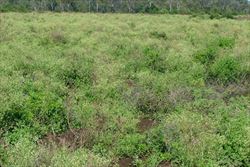
infestation (Photo: Sheldon Navie)
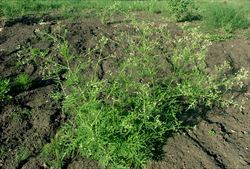
habit (Photo: Sheldon Navie)
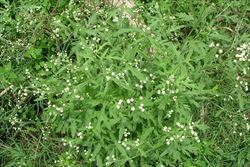
habit (Photo: Sheldon Navie)
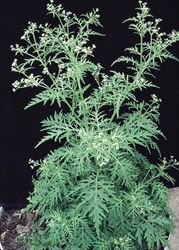
habit (Photo: Land Protection, QDNRW)
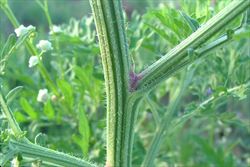
close-up of hairy ribbed stems (Photo: Sheldon Navie)

basal rosette of lower leaves (Photo: Sheldon Navie)

deeply-divided leaves and flowers (Photo: Sheldon Navie)

close-up of deeply-divided lower leaf (Photo: Sheldon Navie)
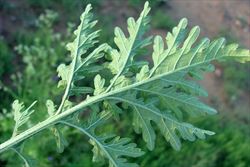
close-up of hairy leaf underside (Photo: Sheldon Navie)
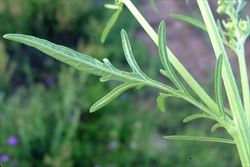
smaller and less-divided upper leaf (Photo: Sheldon Navie)
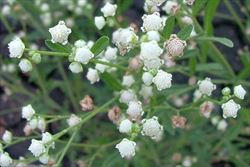
small white flower-heads (Photo: Sheldon Navie)

close-up of flower-heads (Photo: Land Protection, QDNRW)
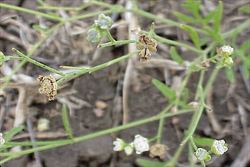
close-up of mature fruit (Photo: Sheldon Navie)
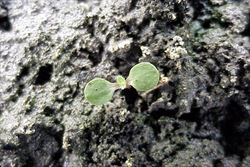
young seedling (Photo: Sheldon Navie)
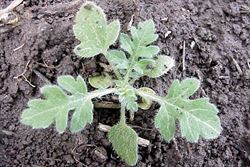
young plant (Photo: Sheldon Navie)
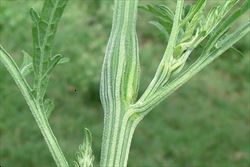
stem gall caused by the larvae of the stem-galling moth Epiblemma strenuana, a biological control agent (Photo: Sheldon Navie)
Scientific Name
Parthenium hysterophorus L.
Family
Asteraceae (Queensland, New South Wales, the ACT, Victoria, Tasmania, Western Australia and the Northern Territory)Compositae (South Australia)
Common Names
bitter weed, bitter-broom, bitterweed, carrot grass, congress grass, false camomile, false ragweed, feverfew, parthenium, parthenium weed, ragweed, ragweed parthenium, Santa Maria, Santa Maria feverfew, white top, whitehead, whitetop
Origin
Native to Mexico, Central America (i.e. Belize, Guatemala and Honduras), the Caribbean (i.e. the Bahamas, Barbados, Cuba, Dominica, Grenada, Haiti, Jamaica, Martinique, Puerto Rico, St. Vincent and Grenadines, Trinidad and Tobago and the Virgin Islands) and South America (i.e. Guyana, Venezuela, Bolivia, Paraguay, Uruguay and northern Argentina).
Naturalised Distribution
This species is distributed mainly in the coastal and sub-coastal districts of central Queensland. It is also relatively common in parts of northern Queensland and present in south-eastern Queensland, inland New South Wales and the Northern Territory.
Also widely naturalised in other parts of the world, including Africa (i.e. South Africa, Mozambique, Kenya and Ethiopia), Madagascar, the Indian sub-continent (i.e. India, Nepal, Bangladesh and Pakistan), south-eastern Asia (i.e. Vietnam, Taiwan and southern China), the Mascarenes (i.e. the Seychelles and Mauritius), eastern USA and Oceania (i.e. Vanuata, Tahiti, New Caledonia and Hawaii).
Habitat
A weed of semi-arid, sub-tropical, tropical and warmer temperate regions. It is found along roadsides, railways and waterways and in pastures, floodplains, grasslands, open woodlands, waste areas, disturbed sites, lawns, gardens and crops. It is particularly aggressive in degraded or disturbed pastures in semi-arid environments.
Habit
A much-branched, short-lived (i.e. annual), upright (i.e. erect) herbaceous plant that forms a basal rosette of leaves during the early stage of growth. It usually grows 0.5-1.5 m tall, but can occasionally reach up to 2 m or more in height.
Distinguishing Features
- a short-lived herbaceous plant forming a basal rosette of leaves in the early stages of growth.
- later producing an upright stems that are ribbed lengthwise, hairy, and much-branched at maturity.
- its leaves are deeply divided and fern-like in appearance, but are smaller towards the top of the plant.
- large numbers of small white flower-heads (4-5 mm across) are borne at the tips of its branches.
- these flower-heads produce five small winged 'seeds' (about 2 mm long).
Stems and Leaves
The greenish-coloured stems are ribbed lengthwise (i.e. longitudinally striate), covered in small stiff hairs (i.e. hirsute), and become much branched at maturity.
The alternately arranged leaves are simple with stalks (i.e. petioles) up to 2 cm long and form a basal rosette during the early stages of growth. The lower leaves are relatively large (3-30 cm long and 2-12 cm wide) and are deeply divided (i.e. bi-pinnatifid or bi-pinnatisect). Leaves on the upper branches decrease in size and are also less divided than the lower leaves. The undersides of the leaves, and to a lesser degree their upper surfaces, are covered with short, stiff hairs that lie close to the surface (i.e. they are appressed pubescent).
Flowers and Fruit
Numerous small flower-heads (i.e. capitula) are arranged in clusters at the tips of the branches (i.e. in terminal panicles). Each flower-head (i.e. capitulum) in borne on a stalk (i.e. pedicel) 1-8 mm long. These flower-heads (4-5 mm across) are white or cream in colour and have five tiny 'petals' (i.e. ray florets) 0.3-1 mm long. They also have numerous (12-60) tiny white flowers (i.e. tubular florets) in the centre and are surrounded by two rows of small green bracts (i.e. an involucre). Flowering can occur at any time of the year, but is most common during spring and summer, and least common during winter.
Five small 'seeds' (i.e. achenes) are usually produced in each flower-head (i.e. capitulum). These achenes (1.5-2.5 mm long) consist of a black seed topped with two or three small scales (i.e. a pappus) about 0.5-1 mm long, two straw-coloured papery structures (actually dead tubular florets), and a flat bract.
Reproduction and Dispersal
Parthenium weed (Parthenium hysterophorus) reproduces by large numbers of seed.
These seeds are dispersed by wind, water, animals, vehicles, machinery (particularly on harvesters and bulldozers) and in clothing. They are sometimes also spread in mud and contaminated agricultural produce (e.g. fodder and grain).
Environmental Impact
Parthenium weed (Parthenium hysterophorus) is one of the 20 Weeds of National Significance (WoNS). It is regarded as a significant evironmental weed in Queensland, and as a potential environmental weed in New South Wales, Victoria, the Northern Territory and Western Australia.
Legislation
This species is declared under legislation in the following states and territories:
- ACT: C1 - notifiable pest plant (a pest plant whose presence must be notified), and C4 - prohibited pest plant (a pest plant whose propagation and supply is prohibited).
- New South Wales: Class 1 - a state prohibited weed. The presence of the weed on land must be notified to the local control authority and the weed must be fully and continuously suppressed and destroyed (throughout the entire state).
- Northern Territory: A - to be eradicated (throughout all of the Territory), and C - not to be introduced into the Territory.
- Queensland: Queensland: Class 2 - landowners must take all reasonable steps to keep land free of this species (throughout the entire state). It is also illegal to sell a declared plant or its seed in this state.
- South Australia: 1@ - this species is declared in Class 1c(ii), a classification for prohibited terrestrial plants. The presence of this species must be notified and it must be destroyed (throughout the entire state).
- Tasmania: D - the importation or sale of this species is prohibited and measures to reduce its population in an area, eradicate it from an area, or restrict it to a particular area may be required.
- Victoria: S - prohibited from the state and is to be eradicated if found.
- Western Australia: P1 - trade, sale or movement into the state prevented, and P2 - to be eradicated (throughout the entire state).
Management
For information on the management of this species see the following resources:
- the National Weeds Strategy Strategic Plan for this species, which is available online at http://www.weeds.org.au/docs/pthstrat.pdf.
- the Parthenium Weed Management Manual, which is available online at http://www.weeds.org.au/WoNS/parthenium/.
- the Biosecurity Queensland Fact Sheet on this species, which is available online at http://www.dpi.qld.gov.au.
- the Northern Territory Department of Natural Resources, Environment and The Arts Agnote on this species, which is available online at http://www.nt.gov.au/weeds.
- the New South Wales Department of Primary Industries Agfact on this species, which is available online at http://www.dpi.nsw.gov.au.
- the Victorian Department of Primary Industries Landcare Note on this species, which is available online at http://www.dpi.vic.gov.au.
Similar Species
Parthenium weed (Parthenium hysterophorus) can be confused with annual ragweed (Ambrosia artemisiifolia), perennial ragweed (Ambrosia psilostachya), burr ragweed (Ambrosia confertiflora) and lacy ragweed (Ambrosia tenuifolia) when in the vegetative stage of growth. However, parthenium weed (Parthenium hysterophorus) can be distinguished from all these species by its ribbed stems, and also by white flower-heads (i.e. capitula) when it is in flower.
The fleabanes (e.g.. Conyza bonariensis, Conyza canadensis, and Conyza sumatrensis) are also reasonably similar, but do not have highly dissected leaves or ribbed stems, and their seeds are topped with a ring (i.e. pappus) of whitish hairs.

